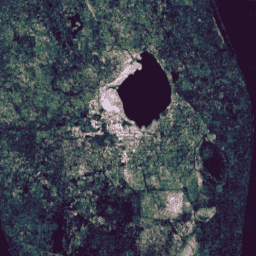
- 데이터 세트 사용 가능 기간
- 1999-01-01T00:00:00Z–2020-01-01T00:00:00Z
- 데이터 세트 제공업체
- 태그
설명
이 컬렉션에는 20년간의 Landsat 표면 반사율 데이터에 연속 변화 감지 및 분류 (CCDC) 알고리즘을 실행하여 사전 계산된 결과가 포함되어 있습니다. CCDC는 동적 RMSE 임계값을 사용한 조화 함수 피팅을 사용하여 시계열 데이터의 중단점을 감지하는 중단점 찾기 알고리즘입니다.
이 데이터 세트는 1999년 1월 1일부터 2019년 12월 31일 사이에 촬영된 모든 주간 이미지를 사용하여 Landsat 5, 7, 8 Collection-1, Tier-1, 표면 반사율 시계열에서 생성되었습니다. 각 이미지는 'pixel_qa' 밴드에 따라 구름, 그림자 또는 눈으로 식별된 픽셀, 포화된 픽셀, 대기 불투명도가 300보다 큰 픽셀('sr_atmos_opacity' 및 'sr_aerosol' 밴드로 식별됨)을 마스크 처리하기 위해 전처리되었습니다. 북쪽/남쪽 장면 오버랩에서 반복되는 픽셀이 중복 제거되었습니다. 결과는 위도 -60°~+85° 사이의 모든 육지에 대해 2도 타일로 출력되었습니다. 이미지는 하나의 전역 이미지로 간단히 mosaic()하기에 적합합니다.
dateFormat를 제외한 기본 알고리즘 매개변수로 CCDC 알고리즘이 실행되었습니다.
- tmaskBands: ['green', 'swir']
- minObservations: 6
- chiSquareProbability: 0.99
- minNumOfYearsScaler: 1.33
- dateFormat: 1 (분수 연도)
- lambda: 20
- maxIterations: 25000
출력의 각 픽셀은 가변 길이 배열을 사용하여 인코딩됩니다. 각 배열의 외부 길이 (축 0)는 해당 위치에서 발견된 중단점 수에 해당합니다. coefs 대역에는 2차원 배열이 포함됩니다. 각 내부 배열에는 선형 조화 모델의 8개 항에 대한 스케일링 요소가 [offset, t, cos(ωt), sin(ωt), cos(2ωt), sin(2ωt), cos(3ωt), sin(3ωt)] 순서로 포함됩니다. 여기서 ω = 2Π입니다. 모델은 광학 밴드의 경우 반사율 단위 (0.0~1.0)를 생성하고 열 밴드의 경우 도 (K) / 100.0을 생성하도록 조정됩니다.
출력 밴드는 배열이며 SAMPLE 피라미드 정책을 사용해서만 다운샘플링할 수 있습니다. 확대/축소 수준이 낮으면 결과가 더 이상 전체 해상도 데이터를 나타내지 않으며, 예를 들어 다운샘플링된 마스크로 인해 타일 경계가 표시될 수 있습니다. 따라서 240m/픽셀 미만의 해상도에서는 이 데이터 세트를 사용하지 않는 것이 좋습니다.
2019년 이후 애셋을 이 데이터 세트에 추가할 계획은 현재 없습니다.
대역
픽셀 크기
30미터
대역
| 이름 | 픽셀 크기 | 설명 |
|---|---|---|
tStart |
미터 | 각 세그먼트의 시작 날짜 (분수 연도)가 포함된 1차원 배열입니다. |
tEnd |
미터 | 각 세그먼트의 종료일을 포함하는 1차원 배열입니다 (분수 연도). |
tBreak |
미터 | 감지된 각 세그먼트의 중단점 날짜 (분수 연도)를 포함하는 1차원 배열입니다. |
numObs |
미터 | 각 세그먼트에서 발견된 관측치 수를 포함하는 1차원 배열입니다. |
changeProb |
미터 | 감지된 중단점이 실제일 의사 확률입니다. |
BLUE_coefs |
미터 | 각 세그먼트의 파란색 밴드에 대한 조화 모델 계수를 포함하는 2D 배열입니다. |
GREEN_coefs |
미터 | 각 세그먼트의 녹색 밴드에 대한 조화 모델 계수를 포함하는 2D 배열입니다. |
RED_coefs |
미터 | 각 세그먼트의 빨간색 밴드에 대한 조화 모델 계수가 포함된 2D 배열입니다. |
NIR_coefs |
미터 | 각 세그먼트의 근적외선 대역에 대한 조화 모델 계수를 포함하는 2D 배열입니다. |
SWIR1_coefs |
미터 | 각 세그먼트의 단파 적외선 (1.55μm~1.75μm) 대역에 대한 조화 모델 계수를 포함하는 2D 배열입니다. |
SWIR2_coefs |
미터 | 각 세그먼트의 단파 적외선 (2.09μm~2.35μm) 대역에 대한 조화 모델 계수를 포함하는 2D 배열입니다. |
TEMP_coefs |
미터 | 각 세그먼트의 열 밴드에 대한 조화 모델 계수를 포함하는 2D 배열입니다. |
BLUE_rmse |
미터 | 각 세그먼트에 대한 파란색 밴드의 모델 RMSE가 포함된 1차원 배열입니다. |
GREEN_rmse |
미터 | 각 세그먼트에 대해 녹색 대역의 모델 RMSE를 포함하는 1차원 배열입니다. |
RED_rmse |
미터 | 각 세그먼트의 빨간색 밴드에 대한 모델의 RMSE가 포함된 1차원 배열입니다. |
NIR_rmse |
미터 | 각 세그먼트에 대한 근적외선 대역의 모델 RMSE를 포함하는 1차원 배열입니다. |
SWIR1_rmse |
미터 | 각 세그먼트의 단파 적외선 (1.55μm~1.75μm) 대역에 대한 모델의 RMSE가 포함된 1차원 배열입니다. |
SWIR2_rmse |
미터 | 각 세그먼트의 단파 적외선 (2.09μm~2.35μm) 대역에 대한 모델의 RMSE를 포함하는 1차원 배열입니다. |
TEMP_rmse |
미터 | 각 세그먼트에 대한 열 밴드의 모델 RMSE를 포함하는 1차원 배열입니다. |
BLUE_magnitude |
미터 | 각 세그먼트의 파란색 밴드에 대해 감지된 중단점의 크기를 포함하는 1차원 배열입니다. |
GREEN_magnitude |
미터 | 각 세그먼트에 대해 감지된 녹색 대역의 중단점 크기를 포함하는 1차원 배열입니다. |
RED_magnitude |
미터 | 각 세그먼트에 대해 감지된 빨간색 대역의 절단점 크기를 포함하는 1차원 배열입니다. |
NIR_magnitude |
미터 | 각 세그먼트에 대해 감지된 근적외선 대역의 절단점 크기를 포함하는 1차원 배열입니다. |
SWIR1_magnitude |
미터 | 각 세그먼트에 대해 감지된 단파 적외선-1 (1.55μm~1.75μm) 대역의 크기를 포함하는 1차원 배열입니다. |
SWIR2_magnitude |
미터 | 각 세그먼트에 대해 감지된 단파 적외선-2 (2.09μm~2.35μm) 대역의 크기를 포함하는 1차원 배열입니다. |
TEMP_magnitude |
미터 | 각 세그먼트에 대해 감지된 열 밴드의 중첩을 포함하는 1차원 배열입니다. |
이용약관
이용약관
